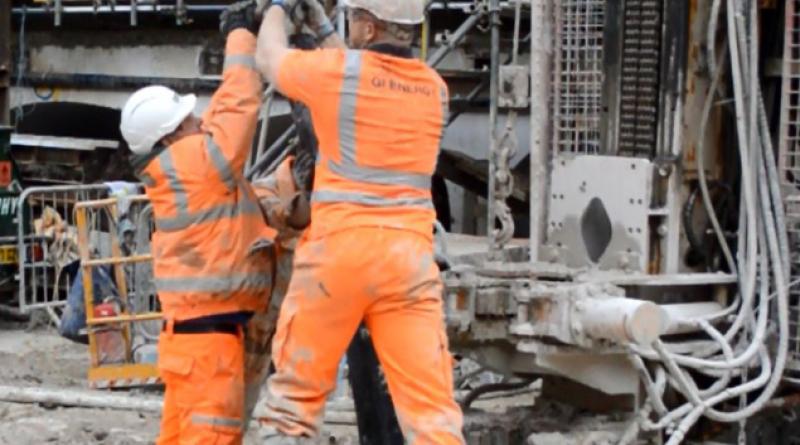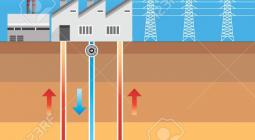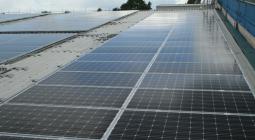Geothermal Energy: Harnessing heat from the shallow Earth.

When it comes to developing low-carbon technology solutions, one of the answers lies right beneath our feet. Ground-source heat pumps harness the heat from the shallow Earth – providing a source of renewable energy for heating (and sometimes cooling) buildings. As with all renewable energy, however, the uptake of these systems is dependent on a range of economic and political factors, which can vary widely between nations.
To learn about the science and technology of these systems,Physics World’s James Dacey catches up with Neil Lawson from GI Energy. An engineer with a range of international experience, Lawson shares his thoughts on the prospects for this technology in the UK against the backdrop of renewables commitments and Brexit uncertainty. He also speaks about the innovative dual heat pump system installed at the new London office of the Institute of Physics (which publishesPhysics World magazine).
What are the different types of geothermal energy?
Geothermal energy is heat from the Earth. It’s considered clean and sustainable and we can think about it coming from two main sources. One is hot water and hot rock, which are found a few miles beneath the Earth – unless you are somewhere like Iceland where it bubbles to the surface. The other is shallow ground, or ambient geothermal energy, and that’s where my interest lies.
How did you become interested in this subject?
I find this topic so inspiring and interesting because of its simplicity. I’ve hosted a number of school tours around installations that we’ve carried out at the University of Oxford, because it encapsulates many of the theoretical subjects learnt as part of the physics school curriculum today. The heat pump and shallow geothermal represents a real living, breathing example of how classroom theory works in real life, and the benefit it gives us.
This heat pumps deals with Boyle’s Law, Charles’ Law, leading to the Combined Gas Law. It encapsulates conservation of energy, change of states, fluid dynamics. This is all at the heart of the geothermal heat pump system, which compresses a low-grade heat or an ambient heat and turns it into high grade heat, where it becomes useful.
Do you find the general public share your enthusiasm for the underlying scientific principles of heat pumps?
When I do a talk, I ask people to put their hands up if they have a heat pump in their house. You might get 5–10% put their hands up, but the answer is, “actually, you all have them, because you’ve all got fridges in your kitchen”. A fridge basically has a radiator in the back of it giving out warmth, while it’s cooling the inside. We’re just transferring energy from one phase to another, in heating or cooling.
So in the case of our heat pumps, the plate on the back of the fridge is actually what we’re using as a radiator or to heat a process, and the cold inside the fridge is the energy we’re absorbing from the ground. So in a fridge, the heat comes from food to keep it cool, but in a heat pump it comes from the ground.
The heat pump and shallow geothermal represents a real living, breathing example of how classroom theory works in real life, and the benefit it gives us
What technologies are involved in harnessing heat from shallow ground?
There are a number of methods in shallow, where we look at open-loop or closed-loop. Open loop deals with a fluid that’s open to the elements, so it could be a river, a lake or an aquifer. Whereas in closed loop we bury pipes in the ground or in a thermal pile and we put a heat transfer fluid through those pipes and we absorb energy. In London, most of the commercial jobs we do use vertical boreholes, or an aquifer, or energy piles, or a mixture of all three.
The beauty of the closed-loop system is that the environment it’s in is controlled, and we have a barrier between our fluid and what we’re absorbing from. Open loop is susceptible to foreign bodies coming in, so there’s a high amount of filtration required. For example, if we’re taking from a river, there might be debris floating upstream, such as silt. Or if you’re close to the sea, the salt content can start to play havoc with pumps and heat exchangers.
In these systems, what do you need to do before you can get a useful amount of heat – to warm radiators for instance?
This is where we go back to our high-school physics. We might be using a compressor, it might be a scroll compressor or a screw compressor or a reciprocating compressor. We’re taking a low-grade heat, so the common refrigerants that are available, something like R4O7C, R410A, they boil at –20 °C. It’s all about this change of phase from a gas to a liquid and then back to a liquid again, and how we can compress and expand a gas. That’s what we’re exploiting.
On the low-pressure side of the heat pump cycle we have a liquid at less than –20 °C. When it comes into contact with a relatively warmer fluid, we can turn that cold liquid into a gas. That gas absorbs heat from the ground. We then pass that gas into a compressor, where it’s compressed and that’s where we convert our low-grade heat into high-grade heat by using electricity to compress it. We’ve got something at say, plus 5 °C on the source side, that’s gone into the compressor, we’ve compressed it up to 30 bar. We’ve then got a refrigerant running at potentially 120 °C. We then put that through a plate heat-exchanger and we transfer that heat into a thermal fluid. It might be water through your radiators, it might be a heating process.
How do you measure the efficiency of your system?
There’s a figure called the coefficient performance, which is the heat pump’s equivalent of “miles per gallon”, as in a car. Heat pumps are measured under a European standard called EN14511, which defines the conditions that they operate at, very similar to a car running at 50 mph. A source side temperature of zero degrees centigrade, and heating water temperature of 35 °C, gives us a coefficient performance that with modern heat pumps is around five, or in excess of five. So, when running at peak power, for one kilowatt of electricity we can generate thermal heat at 5 kW. That equates to an efficiency of 500%. If you equate that to a gas boiler, they’re at 80-plus per cent efficient. So you can see, in terms of transferring energy from one medium to another, heat pumps are very attractive.
In terms of looking at the UK, as it stands, how widespread is this technology?
The technology’s available to everyone, but the take up has been disappointingly slow. Prior to 2008 there was something called the Merton Rule, where Merton Council came out with a guidance that all new developments should have 10% renewables. That promoted the uptake of ground source heat pumps, because it was easy to achieve that. Then in 2008 legislation changed and moved in favour of combined heat and power (CHP), so burning gas to produce electricity and heat. But in the last six months to a year, we’ve seen it go back the other way now. So CHP has had its 10 years of glory, and now it’s coming back to heat pumps. This has been due to the reducing carbon content of grid electricity generated with renewable forms of energy such as wind, PV and hydro.
In the Spring Statement on 13 March 2019, the UK’s chancellor of the exchequor announced the end of fossil-fuel heating in all new homes from 2025. Not wanting to be too cynical, but this was meant to be the case from 2016 but the house builders had all the building codes watered down.
In terms of the UK’s situation with renewables, are you positive that things are moving in the right direction?
Well the Renewable Heat Incentive is here until April 2021, which isn’t that far away. If we look at where politicians are focusing their energy at the moment, it’s Brexit, and unfortunately they’ve taken their eye off everything else. There’s no time between now and 2025, any parliamentary time to put anything new through. So I think we’re going to have a bit of a void between 2021 and 2025, with regards to renewables in general. Not just heat pumps.
But we are seeing results with the London Plan. There’s certainly, in central London, a great emphasis on not burning fossil fuels. Where I’m based in Oxford, we’ve also established a zero emissions zone, banning the use of fossil fuels and fossil-fuel vehicles in the centre, as they declared a climate emergency a couple of weeks ago. Which is probably similar for many cities. We’re seeing with new planning regulations that you can’t burn fossil fuels in the centre of towns, and the only solution is therefore a heat pump. The beauty of the heat pump is that 50% of an office’s load is cooling, and that’s already done by a heat pump, it just happens to be an air-cooled one. If you take the same technology ground coupled, that piece of equipment will do heating and cooling.
How do other European nations fare when it comes to heat pumps?
If you look at somewhere like Scandinavia, Sweden especially, they don’t have natural gas and oil of their own, therefore their heating oil prices were at petrol pump prices, whereas in England we’re quite heavily subsidized. So for them, economics necessitated innovation, and meant that heat pumps have been mainstream in Sweden since the 1950s. You go into any house there and it has a heat pump. It’s very mature technology for them. In Sweden, if you gave a Swedish plumber a condensing gas boiler, he wouldn’t have a clue what to do with it. In England, if you give a condensing gas boiler installer a heat pump, they don’t really have a clue what to do with it. Our biggest challenge here is gearing people up and educating the market.
The wider context is that Germany is certainly driving the renewables mantra. They’re quite reliant on Russian gas and therefore they’ve put a huge investment into PV, wind, etc. I think, on good days, their grid has no fossil fuels on it.
If we look at where politicians are focusing their energy at the moment, it’s Brexit, and unfortunately they’ve taken their eye off everything else. There’s no time between now and 2025, any parliamentary time to put anything new through
Your company, GI Energy, was also involved in the heat pump at the new London office of the Institute of Physics (which publishes Physics World magazine). Tell me about that project?
In that case, we’ve got two heating-only heat pumps, but we have them coupled up in such a way that they can transfer the heat and cold to do what we call “simultaneous heating and cooling”. So in the building you have server rooms or lecture theatres electric theatres which need cooling. In doing so, we can absorb that waste energy and transfer it to places that need heating, and that makes heat pumps 700% or more efficient.
Was that a bespoke design, or is it a system that’s been used elsewhere previously?
One of the new technologies we’ve tried out at the Institute of Physics, was the GeoKOAX probe. Our challenge now is to monitor how much energy we can get from the ground, and try to do it for a more economic price. We’ve installed a very large diameter pipe with a smaller pipe inside it, and that gives us a greater thermal mass in the ground, and allows us to deal with higher peaks. It meant that we could drill at half the depth and get the same energy out, 75 m whereas we would normally drill to 150 m or more.
This is something we’re trialling and watching very closely. It’s popular in Germany because they have a legislation that you can’t drill below 75 m, which is where the technology has been driven. We’ve been putting it into UK geology to see what we can get out and how it works for us.
The IOP building has been described as like a living lab, where data about its performance will be provided to the physics community. From analysis of this data, do you believe the heating/cooling system can be evolved to become even more efficient?
Yes. A theoretical model was put together of how the building’s going to work – how many people will be in it and how it would be built. But, quite often, the reality is very different. So we put in a big system, we start operating it as per the design parameters, and we’ll go in every quarter for the seasonal commissioning and review and tweak and improve. In addition, as a business, we monitor all our systems remotely. 80% of breakdowns we can attend to through the phone line, effectively, and we can monitor and tweak.
What other exciting projects do you have coming up?
Well, we’ve worked on a number of Sainsbury’s supermarkets across the UK, I think about 30 in total, where they’re wasting a lot of heat into the air – all the chilling for their food and freezers uses air-cooled chillers. So we’ve captured that heat, stored it in the ground, and then used it to heat the buildings. Now, here at the Heyford Hill roundabout in Oxford, there’s a big Sainsbury’s store based right next to one of the poorest communities in Oxford, Rose Hill, where a lot of people experience fuel poverty. That store wastes around 600 kW peak of thermal energy. This could be captured, stored in the ground, and then used as a low-grade heat source for those people. If we can get the ground temperatures up to around 25 °C, which we can with refrigeration waste heat, we can offer coefficient of performances of around six or seven. So people will be heating their homes not a £1000 a year, but potentially £100 a year.
And Sainsbury’s themselves, they’re on board with the new project?
Yes, the big benefit to Sainsbury’s is that it halves the cost of their refrigeration, just by ground coupling it. So the ground is a more consistent temperature and in some of them it’s cooler than the air, and that’s where their biggest costs are. They, Sainsbury’s, each year, support a number of academic studies in universities, and I think it’s about three years ago one of the MSc students came up with proof that ground coupling the refrigeration saves your costs. We turned around to Sainbury’s and said “But we’ve been doing that for you for a number of years now, you just call it a heat pump.”
18 March 2019
![]()





